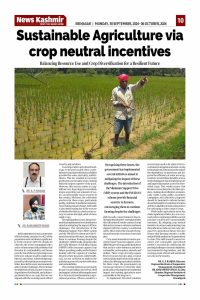Sustainable Agriculture via crop neutral incentives
Balancing Resource Use and Crop Diversification for a Resilient Future
DR. K. P. RANJAN
Director, Regional Institute of Cooperative Management, Chandigarh
DR. RAMANDEEP SINGH
Faculty Member, Regional Institute of Cooperative Management, Chandigarh
India’s agriculture sector, a cornerstone of the economy, sustains over 42% of the population and contributes significantly to the country’s GDP. Yet, despite its vital role, the sector is grappling with a series of interconnected problems that threaten its sustainability and future growth. One of the most pressing issues is the over-reliance on a few staple crops like rice and wheat, which though supported by substantial government subsidies, have led to severe environmental and economic challenges. These include the depletion of critical water resources, degradation of soil health, and a disproportionate focus on crops that are not aligned with the evolving needs of food security and nutrition.
Currently, India’s agricultural landscape is skewed towards these water-intensive crops due to the heavy subsidies provided for water, electricity, and fertilisers. This has resulted in excessive production, particularly of rice, making India the largest exporter of the grain. However, this success comes at a significant cost. Exporting rice essentially means exporting vast amounts of water—an increasingly scarce resource in the country. Moreover, the cultivation practices for these crops, particularly paddy, contribute to methane emissions, exacerbating climate change. Soil health is also deteriorating due to the overuse of chemical fertilisers, which are necessary to sustain the high yields of these staple crops.
Recognizing these issues, the government has implemented several initiatives aimed at mitigating the impact of these challenges. The introduction of the Minimum Support Price (MSP) system and the PM-KISAN scheme provide financial security to farmers, encouraging them to continue farming despite the challenges. Additionally, programs like the Prime Minister’s Fasal Bima Yojana (PMFBY) offer insurance against crop failure, providing a safety net for farmers dealing with the vagaries of weather. However, these measures, while beneficial, are not sufficient to address the underlying issues of crop diversification and sustainability.
The existing solutions are primarily focused on providing short-term relief and support, without addressing the need for a structural transformation in agricultural practices. What is needed is a shift towards a more balanced, diversified agricultural model—one that promotes the cultivation of a wider variety of crops that are less resource-intensive and more aligned with the country’s nutritional needs. This is where the concept of crop-neu tral incentive structures comes into play.
tral incentive structures comes into play.
 tral incentive structures comes into play.
tral incentive structures comes into play.Crop-neutral incentives involve providing equal financial support across different types of crops, particularly those that are less water-intensive and more sustainable, such as pulses, oilseeds, and millets. These crops not only require fewer resources but also play a crucial role in enhancing food security and nutrition. By offering equivalent subsidies for these crops, the government can encourage farmers to diversify their production, reducing the environmental impact and making agriculture more sustainable in the long term.
To implement this ideal solution, several steps need to be taken. First, investments in irrigation and water-saving technologies must be increased to reduce the dependency on monsoons and improve the efficiency of water use in agriculture. Second, there should be a focus on developing post-harvest infrastructure and improving market access for diversified crops. This would ensure that farmers receive fair prices for their produce, making diversification economically viable. Lastly, public awareness campaigns and education programs should be launched to inform farmers about the benefits of crop diversification and the availability of financial incentives for cultivating a wider range of crops.
While India’s agriculture sector has made significant strides, it is at a crossroads where continuing with the current practices could lead to unsustainable outcomes. By adopting crop-neutral incentive structures and promoting crop diversification, India can not only safeguard its agricultural future but also ensure that farming remains a viable and profitable endeavour for generations to come. This shift towards a more balanced and sustainable agricultural model is essential for addressing the pressing challenges of resource depletion, environmental degradation, and the evolving needs of food and nutritional security in the country.





